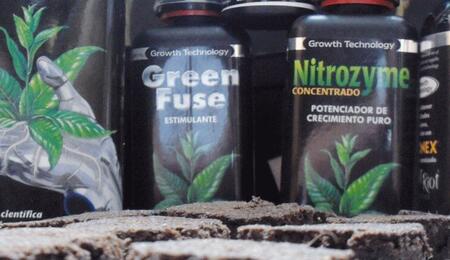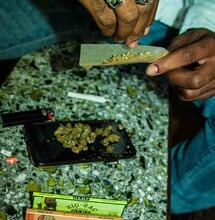Clonex

Taking cuttings is relatively simple and having a constant supply of cuttings is a very effective way to increase the number of annual harvests. Cuttings taken from a mother plant are a genetically exact replica of that plant. When you select a good mother plant, the clones you obtain are as good as it.
The Comeback
If, in addition to that, mother plants are healthy and you have suitable knowledge and tools, you will almost effortlessly obtain cuttings with 100% success rate. Taking cuttings is among the most pleasant tasks. It is relatively easy and the clones obtained only need little maintenance. One or two weeks after taking a cutting, if the procedure is done correctly, it will develop a root system. Selecting a mother plant is a bit more time consuming but, when you do, you can be sure that all its clones are identical and of the highest quality. You need to keep mother plants healthy for cuttings to be strong and grow vigorously since day one. If mother plants have undergone stress or diseases or been re-vegetated, cuttings are likely to be slower in growth and more exposed to diseases, mildew or pests.
Cuttings taken correctly and in optimum conditions adapt perfectly to any growing style, i.e. soil, coconut-husk or hydroponic substrates. They need high room humidity (around 95%), especially in the early days. If you have a fluorescent lighting system, lamps should be placed at a height of 15 to 30 cm (6 to 12 in) above plants. If you use sodium lamps, instead, place them at a minimum height of 1 m (39 in). Ideally, for plant development, air temperature should be in the range of 20 to 24ºC, and the growing medium temperature in the range of 24 to 27ºC. When you take cuttings, all tools coming into contact with them, the working area and the room or tent designed to host clones should be clean and disinfected. For accurate cleaning, use bleach and alcohol.
Mother Plants
A selection made from several seeds of a mother plant is the first step to obtain the best clones. It is a fairly complex task, which requires some time and dedication but, in the end, you will be amply rewarded, as the qualities that encouraged you to select a mother plant for its taste and/or yield will remain unaltered in the offspring. Conversely, if a plant has problems, e.g., poor resistance to mildew, cuttings will be affected by the same problem. A well-groomed and well-nourished mother plant will most likely produce a host of cuttings for many years and flourish in any environment, including outdoors, provided you move it to an indoor space under lamps before mid-June to avoid early blooming.
You also need to wash out the soil and transfer the mother plant, from time to time, to larger pots as it grows. The plant also needs an extra dose of nitrogen, except on the days preceding the taking of cuttings, when you should avoid doing so to stimulate rooting. Once a month, you should also add phosphorus and potassium to favour its regeneration. Make sure you stop fertilisation several days before the taking of cuttings. Wash out the soil and clean leaves with pure water to reduce the nitrogen level, which will speed up rooting in clones.
Cuttings
The best clones to be taken should measure 5 to 10 cm (2 to 4 in) in length and 3 to 6 mm (0.11 to 0.23 in) in diameter and be cut off the mother plant at more than two months of growth. Cuttings are best taken in the medium to lower part of the plant. Make sure to have cuttings with a couple of leaf clusters remaining outside the rooting medium, whereas lower clusters should be removed before introducing the cutting into the medium. Avoid taking cuttings from very small branches, i.e. those with a very small number of leaves or leaf buds. These parts of the plant have lower probability of developing roots, as the leaf and/or stem surface is too small and rooting will be delayed (compared to clones obtained with branches of a suitable size to stimulate rooting). That is why, smaller branches are normally discarded.
Growth Technology
This company was founded in 1985 and, since then, it has devoted itself to the development of innovative, top-quality horticultural products. They are specialised in the development of nutrients for plants and plant propagation. Clonex is its flagship product. This rooting gel is famous worldwide for its excellent results. Other products that stimulate initial plant development include Clonex Mist, Nitrozyme, Green Fuse Root or Formulex.
Clonex
This is the rooting gel par excellence. Using gels is the most effective method for cuttings. They are dense, adhere to the stem evenly and remain stuck to it for longer. Clonex is a purple-coloured gel containing a powerful rooting hormone that causes an amazing root growth. After taking cuttings, dip their base in undiluted Clonex gel to a depth of 10 to 20 mm (0.39 to 0.79 in). Then insert cuttings into the propagation medium, where they will remain in the appropriate conditions for initial root formation. Whenever you use Clonex, make sure you place the quantity you need in a separate bowl to avoid contaminating the remaining product in the bottle.
Root Rioagt Propagation Trays
Growth Technology’s Root Riot is an organic and totally biodegradable propagation tray. It is perfectly clean and does not give off dust. In addition, it comes pre-moistened, so all you need to do is plunge cuttings into it. If the tray dries, just add water to remoisten it. All trays should be wet and spongy, but not swamped.
Clonex Mist
This is a natural, hormone-free root stimulator that makes plants healthy and vigorous. It is designed to work with Clonex rooting gel to produce cuttings with strong, well-developed roots. It comes in the form of a foliar spray to be applied to the tips of mother plants every two or three days for two weeks, before taking cuttings. Cuttings are misted again after being taken and, later, at regular intervals of two or three days.
Green Fuse Root
This product is a highly concentrated organic root stimulator without side effects for plants, people or the environment. It is a powerful mixture of natural plant extracts. High concentration and solubility aid the formation of new roots and the nutrition of young plants. It is also designed to be used in conjunction with Formulex and to enhance rooting and the overall health of the plant.
Nitrozyme
This superb growth booster is extracted from seaweed named Ascophyllum nodosum. It is highly concentrated and contains various vegetable hormones, such as cytokinins, auxins and gibberellins. As it also contains enzymes of natural origin and a high number of micronutrients, it suits all stages of plant growth. In addition, it can effectively be used for the treatment of seeds. Nitrozyme has a broad spectrum of actions: helps germination, increases roots, improves the absorption of nutrients and the composition of the plant tissue, alleviates plant stress and enhances plant vigour and health. Soaking seeds in Nitrozyme 24 hours before sowing will also improve germination.
Formulex
This product is a full-spectrum nutrient solution for all types of plants. It contains 14 essential elements for the healthy growth of plants, including a complete profile of trace elements. Contains all the macro and micro nutrients required for optimum plant growth. An ideal nutrient for seedlings and delicate cuttings. Suitable for irrigation and foliar feeding. Has a stable pH and requires no adjustment with pure water. Suits perfectly to the early stages of growth and mother plants. Can be mixed with Nitrozyme or Green Fuse for better results.
How to take cuttings with Growth Technology products
The cuttings propagation technique is always the same, but we recommend using Growth Technology products to shorten the time of the rooting process and increase the size and number of roots.
- In the days preceding the taking of cuttings, you need to prepare the mother plant. Fertilisation should be suspended, the soil should be amply washed and leaves misted to reduce the nitrogen level and, therefore, speed up the rooting of the clones you will obtain.
- Select cuttings to be rooted ad count them to prepare a suitable number of propagation trays.
- In the two weeks before the taking of cuttings, spray Clonex Mist on the tips of the mother plant, every two or three days.
- Cut plant parts with a very sharp blade, but avoid crushing the end of the stem. Cut at a 45° angle.
- Scrape off the skin of the stem part of the cutting to be placed into the propagation tray and split it in two parts, which will considerably increase the surface that will form roots (i.e. when a larger cambium layer is left uncovered, new roots can be generated).
- If you need to take several cuttings, leave those already taken soaking in water while you take others. Soaking will avoid the entry of air and possible embolisms.
- After preparing cuttings, pour a small quantity of Clonex into a bowl and dip just the base of cuttings in it, only once, to a maximum depth of 2 cm (0.78 in).
- Keep the Root Riot propagation trays wet with holes prepared to introduce stems. After removing cuttings from the Clonex dip, introduce them immediately into the propagation tray. The tray should come into contact with the stem without crushing it. When you introduce the cutting into the tray do not force it inside. If it does not enter easily, just make a larger hole.
- Cut the tips of leaves to reduce the transpiration of new cuttings, prevent leaves from overlapping and minimise the possible appearance of mildew.
- Spray cuttings again with Clonex Mist on the same day they are taken.



